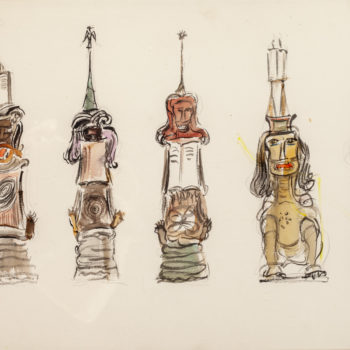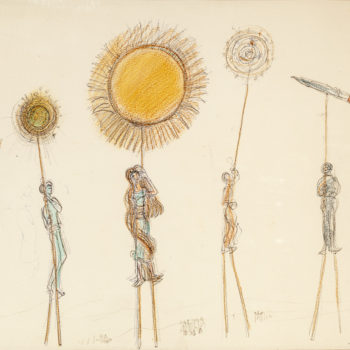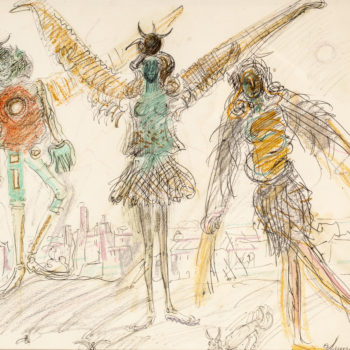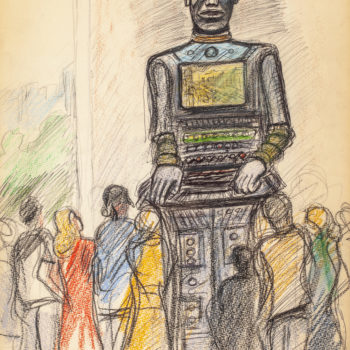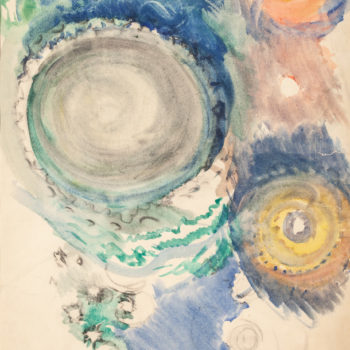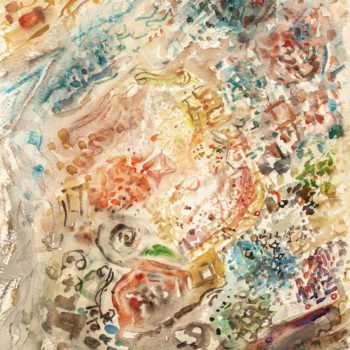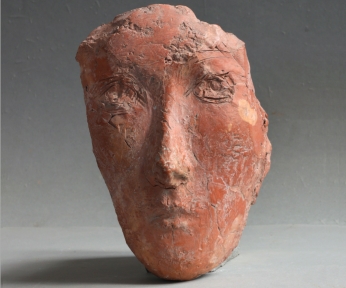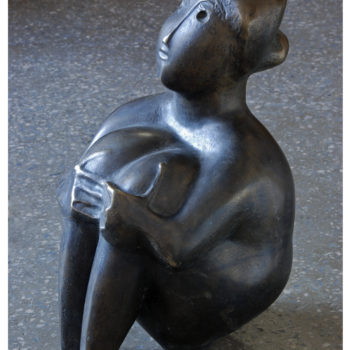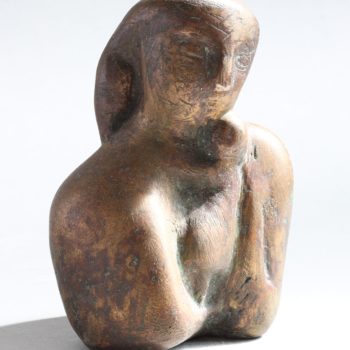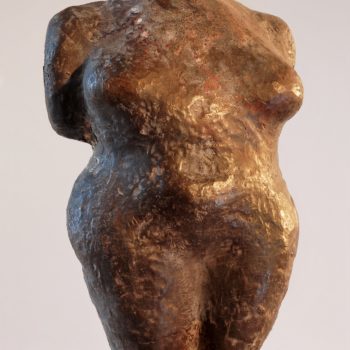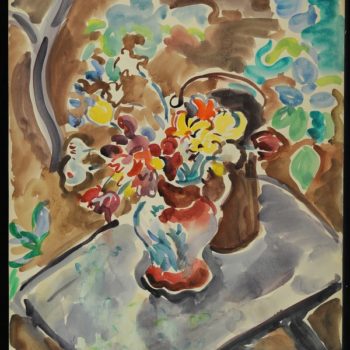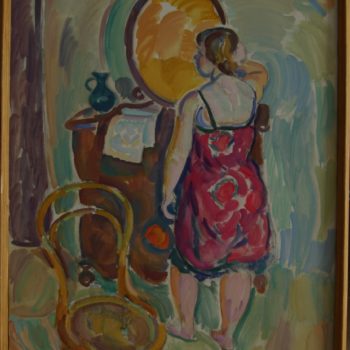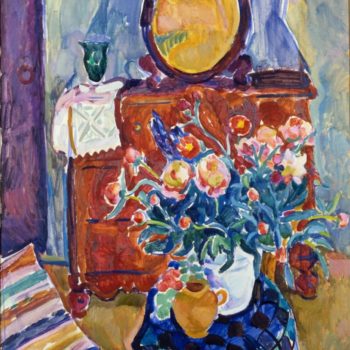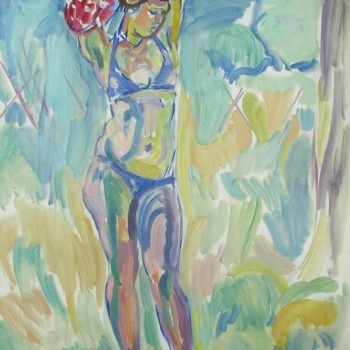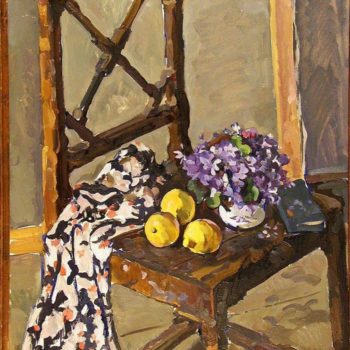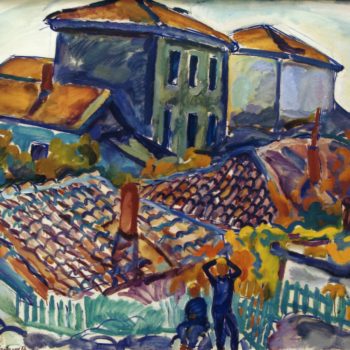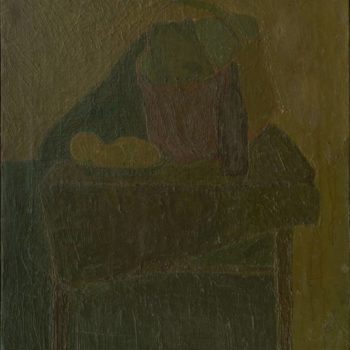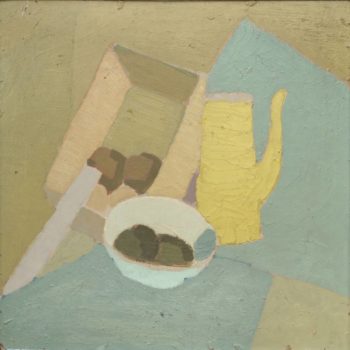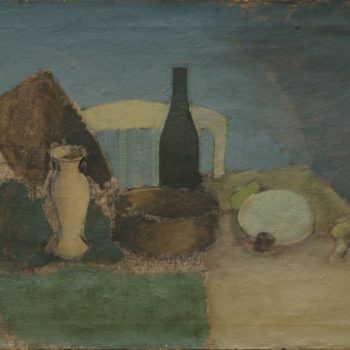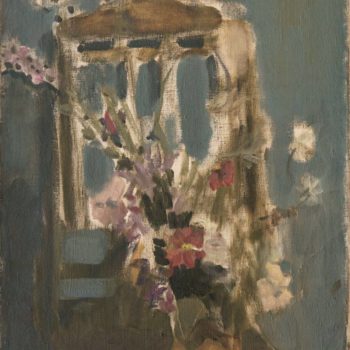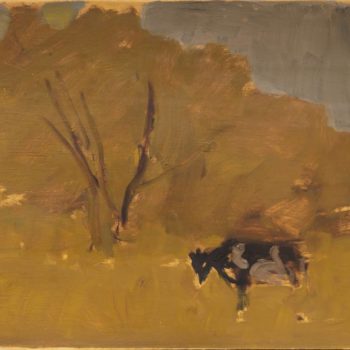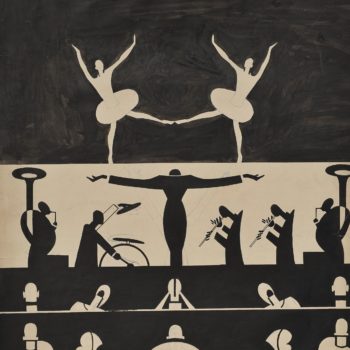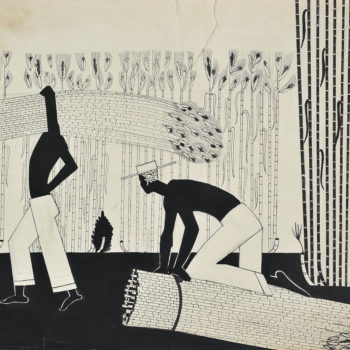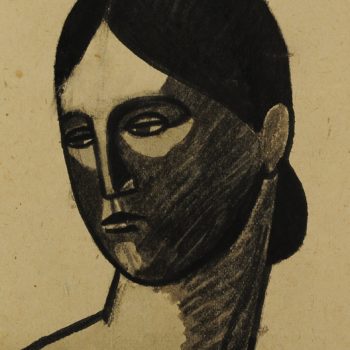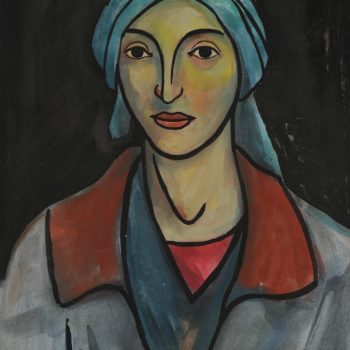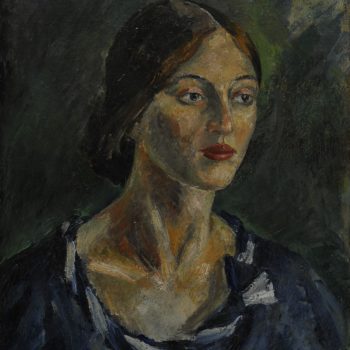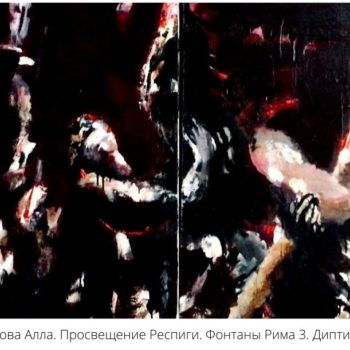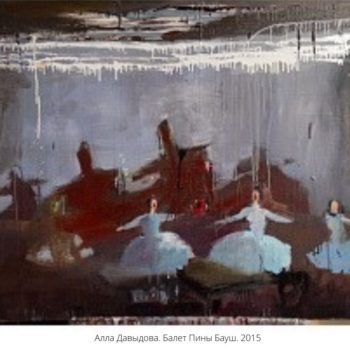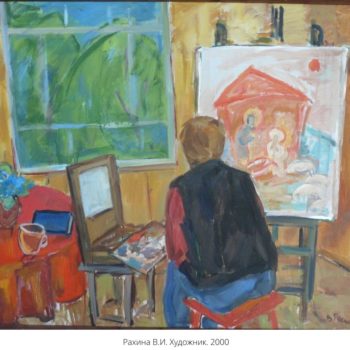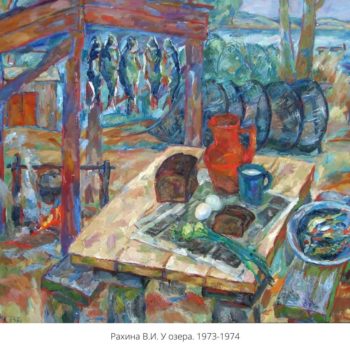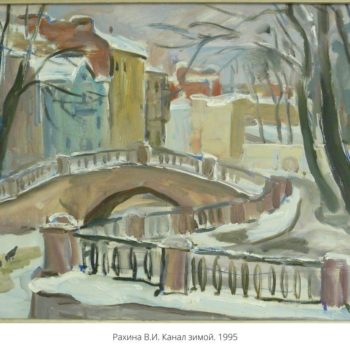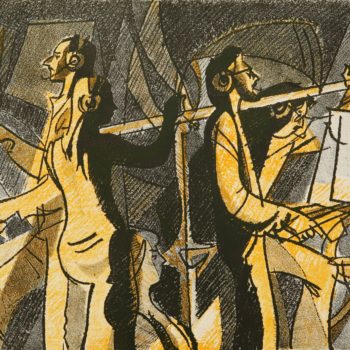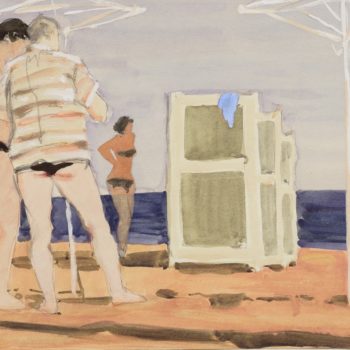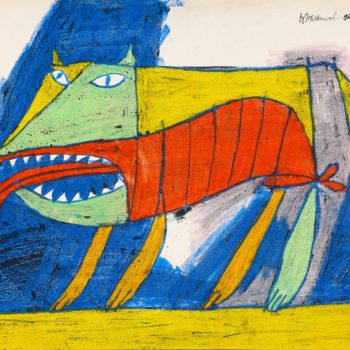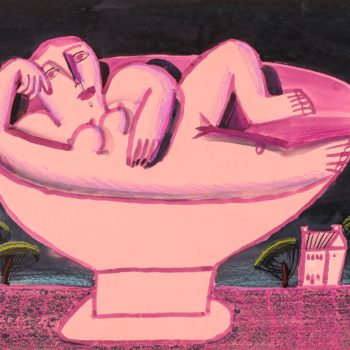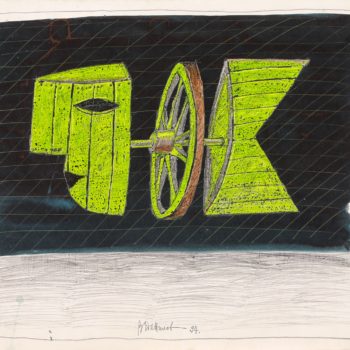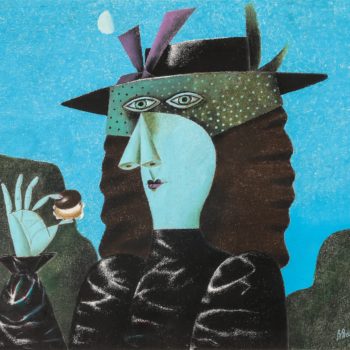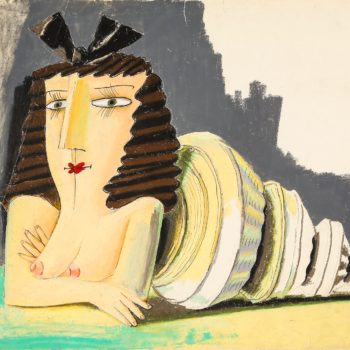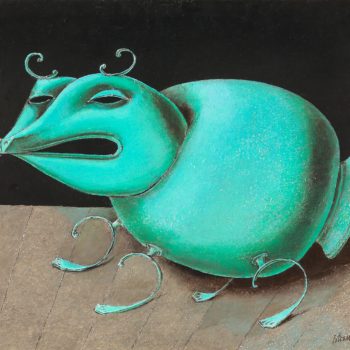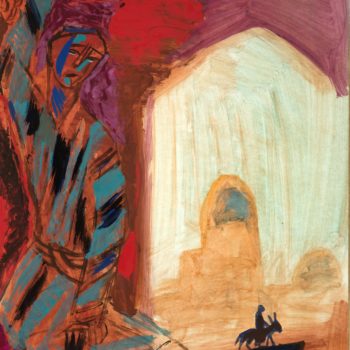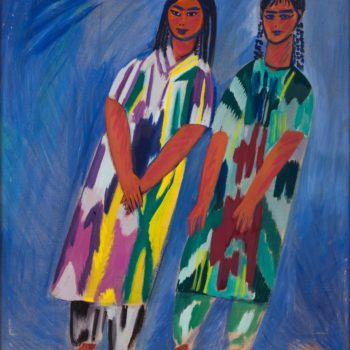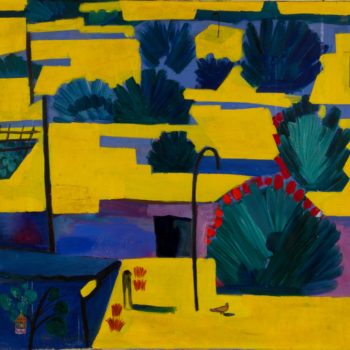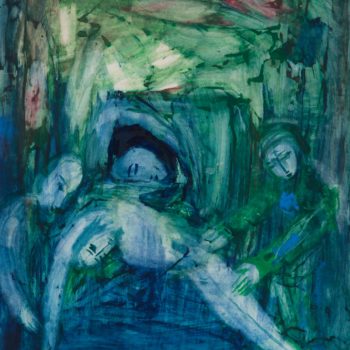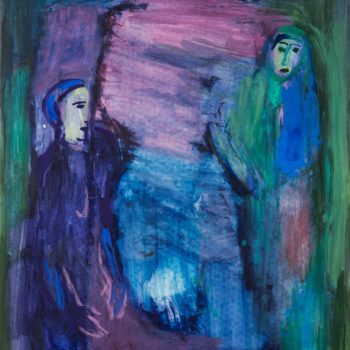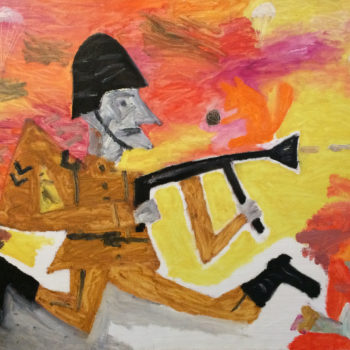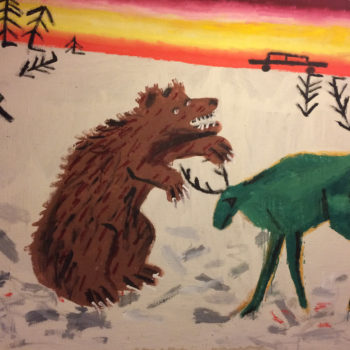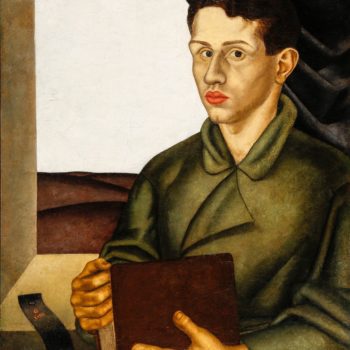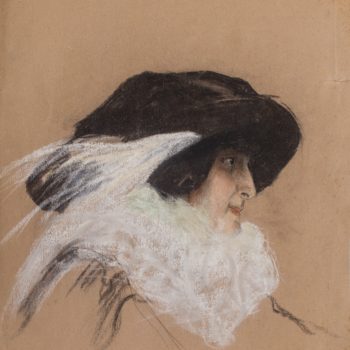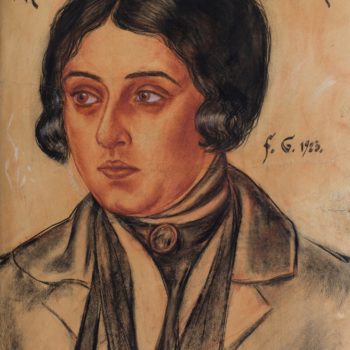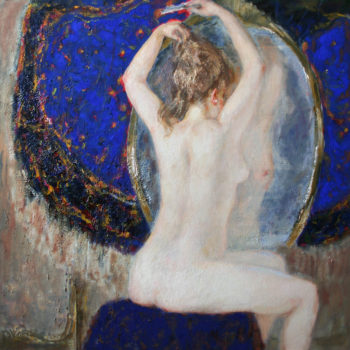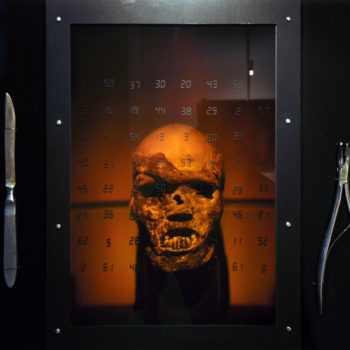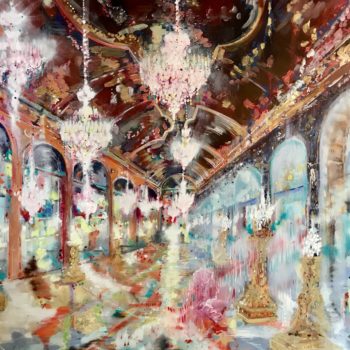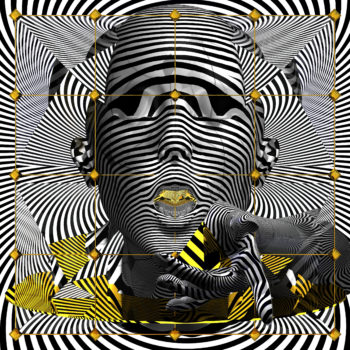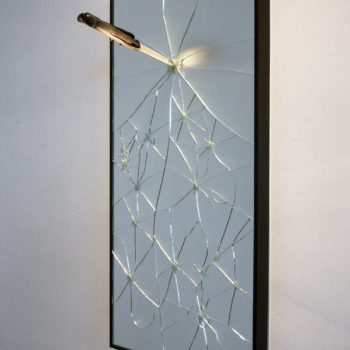Exhibitions
Alexander Labas :Fantasies of Alexander Labas
4 October – 13 November 2022
From 4 October to 13 November, 2022, an exhibition devoted to the outstanding Russian avant-garde artist, Alexander Labas will be held at the Museum of St. Petersburg 20th- and 21st Century Art. Labas’ graphic works will be shown, which, so far, have not been exhibited in St. Petersburg. The works preserved in the artist’s family will be provided by the Foundation for the Preservation of Artistic and Cultural Heritage of the painters Alexander Labas and Raisa Idelson.
 The exhibition presents Alexander Labas as a romantic meditator, a dreamy artist devoted to his art. His very original drawings, executed in various techniques, evoke a sense of miracle. With his art, the painter-romantic glorified Mankind’s achievements looked at through the eyes of a visionary.
The exhibition presents Alexander Labas as a romantic meditator, a dreamy artist devoted to his art. His very original drawings, executed in various techniques, evoke a sense of miracle. With his art, the painter-romantic glorified Mankind’s achievements looked at through the eyes of a visionary.
His are prophetic words, “I am convinced that with each decade my works will be understood better and better, and in 50 or 100 years they will resound in full force, and everyone will see our time in them…”. One hundred years have passed and the poetically creative works of the master have become more timely that ever, and the time depicted in them appears full of enthusiasm and inspiration.
The compositions of the 1960s – 70s presented at the exhibition are colorful, free fantasies of the artist, creating the aesthetics of the new world. He is telling, as it were, a heartfelt story about cosmic discoveries, about the incipient future, about human conquest of boundless spaces and infinite time.
The Color Compositions cycle, with most its drawings based on the interaction of colored spots, circles and intricate lines, reminds one of the whimsical and unpredictable human mind. In these works, nature, and more broadly, space, surround people, making them part of one and the same world. Portraits with figures dancing, sitting, sleeping, and floating in weightlessness fall into some parallel universes, filled with lucid dreams.
The Inhabitants of Distant Planets series tells about strange anthropomorphic creatures that could become characters of some intergalactic saga. The Fantasy series is populated by a variety of biomorphic creatures, symbiotes. According to the artist, all could coexist peacefully with humans, surrounded by unprecedented beauty of nature that hassurvived in the technogenic world.
Each series has a number of sheets with abstract colorful constructions. Upon closer examination, however, it becomes clear that they, too, are devoted to man as a part of the vast Space.
Alexander Arkadievich Labas (1900 — 1983) was a Soviet artist, representative of the Russian avant-garde and post-Futurism of the 1920s – 30s, one of the founders and member of the Society of Easel Painters. He started painting at the age of 6, at first in the studio of Vitaly Mushketov and in the Stroganov Art-Industrial School; he studied and later taught at the Higher Art and Technical Studios (VKhUTEMAS). He studied under Kazimir Malevich, Vasily Kandinsky, Konstantin Istomin, Aristarkh Lentulov and Ilya Mashkov. Author of such works as The First Soviet Airship (1931), The First Steam Locomotive on the Turksib (1931) and In the Subway (1935).
During his long life dedicated to art, Alexander Labas never betrayed his talent. He experimented, sought unusual forms of expression, giving himself devotedly to creative process.
Mikhail Ershov: The allure of the archaic
4 October – 13 November 2022
 The exhibition of Mikhail Ershov’s sculptures and drawings demonstrates a complex life path of the remarkable artist, who has been in a creative search throughout his life.
The exhibition of Mikhail Ershov’s sculptures and drawings demonstrates a complex life path of the remarkable artist, who has been in a creative search throughout his life.
Mikhail Mikhailovich Ershov entered the history of Leningrad art of the 1970s as one of the young artists of the “1970s generation,” capable of a critical approach to reality. At the same time, the artist was no stranger to the problems of contemporary Soviet life and its achievements; he was ready to make sculptural and architectural works for public buildings on the theme of the Young Pioneers, sports, and labor exploits; he participated actively in exhibitions of contemporary Leningrad art.
Born into the family of the remarkable painter Mikhail Ivanovich Ershov, he inherited from his father the deep admiration for nature, for nature, which breathes in all his canvases. The sculptor Ershov had to find his own artistic language, to convey his profound admiration for the immutable power of ever-renewing nature. For the artist, its symbol and embodiment was the female figure.
Even his earliest works are characterized by a laconic, generalized and monumental form, outwardly close to the sculpture of distant epochs, but at the same time, successfully mastered by European artists, from the beginning of the twentieth century on. The Archaic has proved to be attractive due to its many qualities, among them the lack of anatomical knowledge, which throughout history has turned sculpture into a bronze cast from nature. Ancient sculptures, which were the objects of cult, preserving a deep connection with sacred vision of the world, struck our contemporaries with a completely different way of plastic thinking, with their immediacy and such a meaningful plastic generalization of form.
Ershov is an artist of a keen spiritual disposition, who throughout his life has reflected on the problems of art of the past and of his time, but most of all on the responsibility that the Creator has entrusted to him who calls himself an artist and dares to collaborate with Him.
Viktor Teterin: Beauty without Beautifying
4 October – 13 November 2022
 The exhibition is dedicated to the 100th anniversary of the talented Leningrad painter, graphic artist and teacher Victor Kuzmich Teterin (1922-1991), member of the Leningrad Branch of the Artists’ Union and the “Eleven” informal art group.
The exhibition is dedicated to the 100th anniversary of the talented Leningrad painter, graphic artist and teacher Victor Kuzmich Teterin (1922-1991), member of the Leningrad Branch of the Artists’ Union and the “Eleven” informal art group.
A fundamental influence on Victor Teterin’s work was by Alexander Osmerkin, an outstanding artist, professor of painting at Leningrad Repin Institute of Painting, Sculpture and Architecture, a member of the “Jack of Diamonds” art group. It was he who taught the young artist that “the highest goal … both in drawing and painting is to convey the great form” and that color “serves only to reveal form and organize space.”
In search of his own style, Victor Teterin tried his hand in different techniques and genres, creating landscapes, portraits, still lifes and genre compositions. Eventually, still life became the only genre close to his perception of the world, capable of expressing the artist’s vision and which has become a real creative laboratory of the language of painting -.
Typical of Teterin’s art was the ability to see “the unadorned beauty” even in everyday life and to convey, through still life, his vision of the world and his subjective perception of the fragments of real life. At the same time, the artist had the “broad vision” learnt from Osmerkin. He included in his painting absolutely opposite feelings, severe and tender, ordinary and romantic, that constitute diversity of life.
In contrast to the technogenic and rationalistic practicalism, Teterin’s values were of emotional and spiritual nature. He accepted reality in all its complexity, which sounds unequivocally in his statement: «Through still life and landscape, more often without figures, I show an ordinary piece of life, as a rule, with simple objects, but they are — I would like to believe it! — poeticized by the presence of life around them, and this gives them meaning and justifies their existence.”
Breathing Overground: Yuri Nashivochnikov
30 June – 7 August 2022
The exhibition dedicated to 100th anniversary of Yuri Nashivochnikov will be held in the Museum of St. Petersburg 20th — and 21st Century Art from 30 June to 7 August 2022
The exhibition is a retrospective of the work of Yuri Nashivochnikov, from the early academic works to programmatic landscapes and still lifes, revealing the creative method of the author. Yuri Nashivochnikov is a master of deep and delicate paintings. His work is an important milestone in the history of the art of Leningrad — St. Petersburg in the 20th-21st centuries.
“Summing up my entire creative path, four periods can be discerned, those of the Sidlin School, the Temple Wall School, Symbolism and the Cosmic Harmony School. At the same time, it is a work that has no end, and besides, the periods do not replace one another, but complement each other in their interrelationship.”
Yuri Nashivochnikov
Yuri Nashivochnikov received his professional education from outstanding artists, creators of their own pedagogical systems, the sculptor Alexander Matveev and the painter Osip Sidlin. They not only revealed the scale of the artist’s talent, but also fostered in him a deep understanding of art. This largely determined his further creative path, inextricably linked to the comprehension of the mystery of Painting and philosophy of Being.
The notion of the picture plane as a snow-white wall of the temple, filled with philosophical and spiritual meaning, became for Yuri Nashivochnikov an inexhaustible source not only of his personal creative search, but also of his experiments in the context of his own «Temple Wall» school.
The works, simple to the point of asceticism, both in terms of genre and subject matter, are always aimed at increasing the susceptibility of the nature of objects and phenomena, as well as their invariable poeticization. Inheriting the creative principles of his teachers, Nashivochnikov turned to nature as a boundless source of meanings and opportunities. Even in the simplest subject he reveals not only the aesthetics of pictorial relations, subtly built on elusive, fragile color combinations, but primarily the deep inner content.
The landscapes displayed reflect Nature’s spiritual experience. Each canvas is an emotional illumination, according to the artist, a certain elevated impression of an encounter with the world. Always different states, the atmosphere of nature, from quietly peaceful, to brooding gloomy in some works are broadcast with the help of rusty green, olive and ochre colors. Whereas in other landscapes the palette becomes clearer, the clear colors resound in the canvas conveying the undoubted beauty of the scenery itself.
The author’s still-lifes show his coloristic acumen and amazing ability to organize the plane with the help of several color patches. At times, repetitions of the same scene emerge in series, revealing the essence and color and plastic content of the depicted objects. It is in this repetition that the «Sidlin upbringing,» the very attitude towards creativity as an ongoing exploration, can be discerned. The velvety softness of the painting surface, the harmony of forms in their interaction and clarity and restrained intensity of color combinations engender the balance and power of Nashivochnikov’s compositions.
Revealing the Past: Ivan Petrovsky
5 April – 10 May 2022
“Discovering the Past” is the first exhibition devoted to the work of Ivan Mikhailovich Petrovsky (1902 –1941), a Leningrad artist who died in the first year of the Great Patriotic War. The exhibition includes expressive portraits, interior scenes and still lifes in various graphic techniques. They allow viewers to discover a new name in art and become acquainted with the author of a deep and diverse talent. The unique heritage of the artist was transferred to the museum in 1993 by the will of his wife, Tamara Khmelnitskaya. For many years, the Museum has conducted a serious research concerned with the attribution and restoration of the works, reconstructing the memory of the artist and studying his work and life on the basis of short notes of his compatriots and miraculously preserved diaries.
The art of Ivan Petrovsky is a brilliant artistic phenomenon, integral in its aesthetic and emotional perception of the epoch. At the same time, events of personal character are woven into the artistic fabric of images imbued with a special poetic expressiveness and acute observation in the reproduction of life.
Petrovsky’s most active period was the 1930s. The works then created combine two main thematic lines. The first, lyrical, is depictions of his beloved wife Tamara Khmelnitskaya. These are portraits that perfectly convey not only the facial features of the young beautiful woman, but also the sophistication of her nature and depth of character. The compositions depicting scenes of private intimacy with the same model are permeated by a desire to capture the immediacy of various moments in life: playing music on the piano, reading a book by an open window, lying on a sofa, sleeping on a bed (Female Head, 1932; Profile, 1932; Woman Sitting, 1932; Breakfast, 1932; Woman in Blue by an Open Window; Woman with a Hat, 1932; Woman in Bed, 1932). Cup of Tea, 1930s; Woman in Blue by the Piano, 1932).
The second line is black-and-white graphic narrative compositions, posters and billboards, executed in an acute, expressionistic manner. They reveal Petrovsky’s interest in artistic experiments, in avant-garde movements, such as constructivism and cubism, which influenced the minds and passions of many masters of those years. With graceful, rhythmically arranged lines, the author reveals the shape of the object, accentuating the plane of space and saturating the images with movement and internal dynamic expressiveness. The exhibition features two graphic series: dedicated to the theater (Orchestra, 1932; Concert, 1932; Ballet, 1932) and field service (Army Kitchen, 1930s; Lumberjack, 1930s; Meal, 1930s).
The exhibition Discovering the Past presents the legacy of an artist with a bright, original talent, whose work will be an undeniable discovery not only for a wide range of viewers, but also for the professional community.
Air Routes: Alla Davydova
5 April – 10 May 2022
 The Air Routes exhibition at the Museum of St. Petersburg 20th- and 210th- and 21st Century Art is devoted to the later period of the Honored Artist of the Russian Federation, the painter and tapestry master, Alla Davydova of St. Petersburg. The name of the exhibition reflects the wide range of the artist’s interests and her ability to overcome freely the boundaries between different kinds of art.
The Air Routes exhibition at the Museum of St. Petersburg 20th- and 210th- and 21st Century Art is devoted to the later period of the Honored Artist of the Russian Federation, the painter and tapestry master, Alla Davydova of St. Petersburg. The name of the exhibition reflects the wide range of the artist’s interests and her ability to overcome freely the boundaries between different kinds of art.
The artist has devoted most of her life to hand weaving, creating works in a daring expressionistic manner, characterized by monumentality and theatricality, combined with flair for experiment and conciseness of color solutions. The exhibition shows works executed in this technique in different genres, e.g. abstract art (from the Mirages series, 1993 – 94), animalism (Cage, 1999, Dog, 2000), landscape (Gates: Israel, 2000) and children’s portraits (Brothers, 2006).
During the past decade, Alla Davydova has been working mainly as a painter. Creating her own «geography,» the artist executed the Cities series (2015 – 17), where the neo-Gothic Munich is juxtaposed with the flaming Gothic Prague, and sun-scorched Lisbon with Riga drowning in the coolness of the Baltic night. In the next series, she continued to explore the world architectural monuments through the lens of the romantic remains of Greek civilization. A fragment of a ruin and a detail of a sculptural object in her works (No 1 Ruin, 2017, Achilles’ Foot, 2019) acquire an independent meaning, where «color hints» and «school irrefutability» of simple geometric figures are evidence of a time-distant era.
The works in the «theatrical» and the «musical» cycle reveal the theater director’s intentions and the hidden meanings of «stage nonsense.» The Pina Bausch Ballet» and Aida (both 2015) reveal a rare balance of the original «stage nature» and the freedom of pictorial interpretation. A series of canvases, Fountains of Rome (2021) is devoted to the symphonic poem of the same name by the Italian composer Ottorino Respighi. These works show the traits of a «baroque painter,» monumentally thoughtful, attracted to symbolic generalizations and attentive to detail.
The Air Routes exhibition includes over fifty paintings and tapestries.
Just about Life: Valentina Rakhina
5 April – 10 May 2022
 The exhibition Just about Life is dedicated to the 90th anniversary of the outstanding St. Petersburg painter Valentina Rakhina (1932-2013). The name of this master is ingrained in the history of Russian art of the second half of the twentieth century. As one of the most prominent representatives of the leftist wing of the Leningrad Branch of the Artists’ Union, Rakhina was a member of the “Eleven” group, a creative association of Leningrad artists who rallied together in a desire for a change and opposed their individual vision to official art.
The exhibition Just about Life is dedicated to the 90th anniversary of the outstanding St. Petersburg painter Valentina Rakhina (1932-2013). The name of this master is ingrained in the history of Russian art of the second half of the twentieth century. As one of the most prominent representatives of the leftist wing of the Leningrad Branch of the Artists’ Union, Rakhina was a member of the “Eleven” group, a creative association of Leningrad artists who rallied together in a desire for a change and opposed their individual vision to official art.
The exhibition includes 60 works created in the 1970s – 2000s, landscapes, still lifes, interior and and genre compositions from the collection of the artist’s family and the funds of the Museum of St. Petersburg 20th- and 21st Cenruty Art. This is an honest heartfelt story about life, the world beyond one’s visual space, travels, and people. Flowers on the table, kitchen utensils, and ordinary and familiar objects, when put into a still life, become a mobile and plastic pictorial substance, sometimes completely unpredictable in its color variations and complex color transitions. For Rakhina, painting is a field for artistic expression, a meeting place with nature, which she fills with a refined lyricism of feelings and a powerful inner energy. That is why the artist’s landscapes, whether they are urban motifs of St. Petersburg or silhouettes of trees, bridges and boats, are clots of emotions and expressive pictorial sensations of the joy of being. In this way, Rakhina is able to create the effect of involving the viewer in the narrative and aesthetic environment of her works.
The works presented at the exhibition, created throughout the artist’s career, are her philosophical reflections about unpretentious poetic beauty of the life around us, with which we are in daily contact, sometimes without noticing it. The exhibition is an opportunity for each of us to look inside ourselves and around us and discover something new or previously unseen.
The Museum of 20th–21st Century Art of St Petersburg Celebrating 30 Years of Its Collection: Two Large-Scale Exhibitions
22 September –14 November 2021
This autumn, the Museum of 20th–21st Century Art of St Petersburg is organising two large-scale exhibition projects on the occasion of the 30th anniversary of its collection.
«The Museum collection has its own remarkable and distinctive cultural profile. It represents the visual art born in St Petersburg, the art that explores the contemporary processes that have emerged in our city. And this makes our museum fundamentally different from all other museums, and secures its place in the cultural field of the city on the Neva. Nowadays the Museum collection is one of the most significant and substantial Russian collections, which gives a comprehensive idea of the history and dynamics of development of the visual art of Leningrad and St Petersburg during the 20th and 21st centuries. The key theme in the collection policy and in the strategy of the conceptual development of the Museum of St Petersburg Art is the study, preservation and popularisation of the cultural heritage of our city.”
Marina Dzhigarkhanian, Director, Museum of 20th–21st Century Art of St Petersburg
The first of the two anniversary exhibitions, Stikhi-ia-Peterburga (Verses/Elements of Petersburg, September 22 – November 14, 2021), reflects the history of the landscape genre from the 1930s to the present day. The project introduces the incredible wealth of ideas and artistic interpretations that St Petersburg masters of the twentieth century demonstrated when they turned to landscape motifs. Most of the works from the collection on display will be shown to the public for the first time.
«The depictions of the city on the Neva are not ordinary ‘cityscapes’, but reflections of the authors’ experiences, their attitude to the world and to life.”
Marina Dzhigarkhanian, Director, Museum of 20th–21st Century Art of St Petersburg
The name of the exhibition reflects the variety of contexts contained in the works displayed. St Petersburg appears as a Universe of energies, sky and water, rest and movement, material reality and transcendental mysticism, lightness of feelings and drama of passions.
«The spectator will see ‘portraits’ of the city, a pictorial visualisation of its natural and psychological states, an incredibly rich range of feelings and attitudes born of the amazingly expressive reliefs of St Petersburg spaces, light effects, and bursts of creative energies.
Olga Tolstaia, Exhibition Curator
Meditatively dreamy images of the city of the 1930s–1940s, filled with lyrical suspense, created by Vladimir Grinberg, Alexander Rusakov, Nikolai Lapshin, Viacheslav Pakulin, Alexei Pochtenny, Alexander Vedernikov and others, alternate with expressive works of underground artists of the 1950s–1960s, Alexander Arefiev, Vladimir Shagin, Richard Vasmi and Sholom Schwarz.
The works by the classics of the Russian art of the 1970s–1980s, Zaven Arshakuni, Viktor Teterin, Valentina Rakhina and Rufim Frumak have transformed the city’s ‘substance’ into a colourful pictorial extravaganza, entering into a contrasting dialogue with the works of the “Mitki.” The latter’s playful cheerfulness contrasts with the poignant piercing melancholy of the landscapes by Petr Tatarnikov and Petr Konnikov. Beside picturesque motifs reminiscent of metaphysical urban spaces are powerful universal forces of nature, exuded by the images created by Valery Tabulinsky. And the brutal conceptual conventionality in the abstractions of Valery Lucca and Viacheslav Mikhailov discord with the spectacular visions of Anatoly Maslov and Iosif Zisman.
«The masters of the underground depicted views of impersonal, deserted Soviet new residential areas, saturating the cityscapes with anxiety and, at times, even silent hostility. The strained images in works by these artists are appeased by the ephemeral, impressionistic works of Georgy Tatarnikov, Arseny Semionov, and Viktor Goliavkin, who were active during the same period.”
Ekaterina Mikhatova, Exhibition Co-Curator
The history of St Petersburg cityscape, dedicated to the 30th anniversary of the Museum collection, besides giving an idea of its richness and scope, allows one to feel the diversity of St Petersburg culture in the 20th century and of the present day art.
An album has been prepared for the exhibition, which represents profound research carried out by the Museum staff. In it, outstanding personalities of St Petersburg, among them, Nikolai Burov, Tatiana Chernigovskaia, Yuri Temirkanov, and many others, share their views on the works from the collection of the Museum of 20th–21st Century Art of St Petersburg.
_____________________________________________
The second anniversary exhibition, The Complex Spectacle (December 8, 2021 – February 27, 2022), presents acquisitions over the past ten years.
The Museum of 20th–21st Century Art of St Petersburg was officially established in December 2015, on the basis of the collection which had begun in 1991. The status of the state museum, located at 103 Griboyedov Canal Embankment, brought the collection to a new phase, adding to its scope and significance. This led to numerous donations from artists and their heirs, as well as patrons who wished to place the works in collections where they were certain to be preserved for the future. During the past six years, the Museum has received over one thousand gifts. However, the museum has managed to replenish the collection both through official government purchases and through acquisitions at its own expense. These works will also be part of the new exhibition.
The Complex Spectacle exhibition presents works by outstanding St Petersburg masters of different generations and artistic creeds, starting from the 1930s. It will show the collection in a peculiar, sometimes provocative juxtaposition of eras, the intersection of creative ideas, unequal in their aesthetic content and trends that have coexisted and continue to exist side by side in the single space of St Petersburg.
«The collection has first-rate examples of the work of St Petersburg artists. The core of the collection consists of the works by participants in the cultural processes of the late twentieth century, creators of a multifaceted panorama of art from the 1980s to the 1990s. This period coincided with the beginning of the formation of the collection. Naturally, the time factor played a decisive role in the selection of works; special attention was paid to the reflection of artistic phenomena of the period in question. However, it was also evident that the historical perspective could be revealed only through works by the masters who had formed the psychology and the creative spirit of the 1920s–1940s. And it is the paintings and graphic works belonging to the first decades of the twentieth century that constitute the pride of the collection.»
Marina Dzhigarkhanian
Director
Museum of 20th–21st Century Art of St Petersburg
The exhibition will show portraits from the 1920s–1940s, by famous artists, Vladimir Grinberg, Viktor Proshkin, Lidia Timoshenko, Nikolai Lapshin and Alexander Rusakov. The era of Soviet art is reflected in the portraits and genre compositions of the 1960s and 1970s by Valery Vatenin, Kirill Guschin, Nikolai Koshelkov, Viktor Teterin, Boris Shamanov, Olga Bogaevskaia and many others. A restless spirit of creative experimentation and the ideas of the latest achievements of contemporary art pervade the works by Vladimir Kozin, David Plaksin, Ilia Kreidun, Alexander Yeremin, Valeria Nibiru, Vasily Diakov and Ivan Plusch.
The Complex Spectacle exhibition with its more than 300 works (paintings, graphic art pieces, sculpture, and art objects), will be a vivid demonstration of how constantly evolving artistic processes affect the content of museum collections, helping to expand knowledge and understanding of the processes taking place in contemporary culture.
A comprehensive bilingual (Russian and English) catalogue, with introductory articles, artists’ biographies, documentary and archival photographs, will be published for the exhibition, presenting the best works from the collection of the Museum of 20th–21st Century Art of St Petersburg. The publication will help to understand the focal points and the direction of collection development.
Journey along the Coast. What is nearby: Vladimir Zagorov
9 August – 5 September 2021

The exhibition is devoted to the outstanding graphic artists Boris Vlasov and Alexander Skolozubov, whose creative quests of the 1960s – 70s largely influenced the development of Soviet art. Typical of both is freedom of imagery and virtuoso mastery of plastic form. In the focus of their work is the poeticized prose of life. Primarily, they are interested in everyday circumstances in which very significant traits of human psychology manifest themselves.
Boris Vlasov (1936 – 1981) represents a new stage in the development of Leningrad graphic culture. A successor of the Leningrad school of graphic art of the 1920s and 30s, he was in search of new aspects both technical and spiritual. Depicting contemporary life, Vlasov was able to disclose the minute details and demonstrate their significance (On the Beach, 1958; The Start of a Bicycle Race, 1960; In the Train, 1965; Interior with a Window, 1970). His works are characterized by lightness of composition based on precise linear organization that allows one to perceive its inner rhythms and sweeping movements. Vlasov is a master who transforms prose into poetry, bringing enlightened romanticism into reality.

Among Vlasov’s close friends and associates was the graphic artist and book illustrator Alexander Skalozubov (1936 – 2003); his works are also presented at the exhibition. In the focus of his work was life in all its manifestations. His works’ poetry, in general, results from his constant admiring the world. He depicted everything he saw, in a train, on a bus, on the waterfront or in a cafe, recreating with the highest skill the atmosphere of the place and the situation. An expressive clear-cut graphic line is the artist’s main means of representation, which accurately conveys the form and nature of movement in space. His graphic works are filled with lyricism (A Sunny Day, 1980; Friday Night, 1980; The Last Stop, 1990; Garages, 1989).
The exhibition includes over 60 works, color lithographs, watercolors and gouaches, from the collection of the Museum of St. Petersburg 20th- and 21st Century Art and private collections.
Depicting Life: Boris Vlasov and Alexander Skalozubov
9 August – 5 September 2021

The exhibition is devoted to the outstanding graphic artists Boris Vlasov and Alexander Skolozubov, whose creative quests of the 1960s – 70s largely influenced the development of Soviet art. Typical of both is freedom of imagery and virtuoso mastery of plastic form. In the focus of their work is the poeticized prose of life. Primarily, they are interested in everyday circumstances in which very significant traits of human psychology manifest themselves.
Boris Vlasov (1936 – 1981) represents a new stage in the development of Leningrad graphic culture. A successor of the Leningrad school of graphic art of the 1920s and 30s, he was in search of new aspects both technical and spiritual. Depicting contemporary life, Vlasov was able to disclose the minute details and demonstrate their significance (On the Beach, 1958; The Start of a Bicycle Race, 1960; In the Train, 1965; Interior with a Window, 1970). His works are characterized by lightness of composition based on precise linear organization that allows one to perceive its inner rhythms and sweeping movements. Vlasov is a master who transforms prose into poetry, bringing enlightened romanticism into reality.
Among Vlasov’s close friends and associates was the graphic artist and book illustrator Alexander Skalozubov (1936 – 2003); his works are also presented at the exhibition. In the focus of his work was life in all its manifestations. His works’ poetry, in general, results from his constant admiring the world. He depicted everything he saw, in a train, on a bus, on the waterfront or in a cafe, recreating with the highest skill the atmosphere of the place and the situation. An expressive clear-cut graphic line is the artist’s main means of representation, which accurately conveys the form and nature of movement in space. His graphic works are filled with lyricism (A Sunny Day, 1980; Friday Night, 1980; The Last Stop, 1990; Garages, 1989).
The exhibition includes over 60 works, color lithographs, watercolors and gouaches, from the collection of the Museum of St. Petersburg 20th- and 21st Century Art and private collections.
The Poetry of Being: Svetlana Fadeenko
10 August – 5 September 2021

The Poetry of Being is a retrospective exhibition dedicated to the 80th anniversary of the outstanding graphic artist Svetlana Fadeenko. She is one of those brilliant masters, who laid the foundations of the Leningrad graphic school of the second half of the twentieth century. The exhibition presents more than 40 graphic and sculptural works from 1980 – 2020s from the collection of the Museum of St. Petersburg 20th and 21st Century Art, introducing the multifaceted talent of this outstanding artist.
For Svetlana Fadeenko, art is a way of living. Life in a variety of manifestations is the impulse for most of her works, from primitive teapots to lofty Venuses. Independent thinking and great power of imagination allow the artist to capture a moment of ordinariness and transform everyday reality into poetry.

Her gouaches and pastels are characterized by bold compositional design and complex color consonances, similar to those of painting. Fadeenenko’s works do not show clear division into genres, a still life appears in a landscape (Still Life and a Village), a portrait is adjacent to a “nude” (Conversation). Besides, pictorial, graphic and sculptural principles often merge, as in the cycle of works with nudes, where female figures form almost tangible sculptural dimensions (Yellow with a Bird, Woman Sitting with a Blue Jug, Near the House).
Fadeenko’s artistic arsenal has been greatly enriched by printmaking. Among her etchings and lithographs are touching and meditative genre sketches (In the Mountains, Returning from Pasture) characterized by the charm of everyday warmth. Unlike gouaches done in sweeping brush-strokes, here the drawing and elaboration of details come to the fore. However, color is present even in the printed works, reflecting another aspect of the artist’s vision of the world.
Emotional sensitivity generally typical of Svetlana Fadeenko imbue her ceramics. With the help of unexpected juxtapositions of shapes and textures, the artist literally gives a second life to worthless fragments of pottery, which in combination with those she has created make up very original compositions (Head of a Woman with a Bird).
The exhibition demonstrates Svetlana Fadeenko’s inexhaustible imagination revealing the immensity of her artistic world.
More Than Love: Yuri Penushkin
12 June – 11 July 2021
The St. Petersburg artist Yuri Ivanovich Penuskin (born, 1935) has long been regarded as a classic of Russian art of the second half of the twentieth century. His works are preserved in the most imporant musems of Russia.
The exhibition, which includes works from different periods (from 1961 to 2015), is a demonstration of the artist’s.incredibly versatile talent. He works with the same burst of creative energy in different genres, portraiture, Russian landscape, still life, and nude. His characters are sometimes reminiscent of those of the great paintings by Rembrandt (Self-Portrait with Wife, 1979) or Italian masters of the Renaissance (Nude, 1991). It is not by chance that Penushkin is sometimes called a Kustodiyev of the Soviet era. his “nudes” are combine sublimity and majesty (Nude with Valenki near Bathhouse, 1972; Nude with a Rowan Tree and Apples, 1975; At the Mirror, 1980; Morning, 2000; Nude with a Blue Background, 2015). They captivate the spectator by the pearl-like shining of the snow-white skin, graceful forms and smooth curves.

Ю. Пенушкин. Весной. 1970
Yuri Penushkin’s another domain is portraiture. His sitters, as a rule, are those near and dear to him, e.g. his daughter Lyudmila, as in Daddy, I’m here! (1978) or, as a charming young woman, in the Portrait of the Daughter (2000) and, as a mother, in Lyudmila with Alyosha in Her Arms (2000). The model for the country woman in From the Baths (1963) wass the artist’s wife.
The theme of the Russian village also repeatedly recurs in Penushkin’s work. His perception of nature is exclusively optimistic and colorful. His landscapes are filled with the sounds of life. The same Russian beauties gather hay in haystacks, carry water in reeds, wash laundry in the river and hanging it up. The artist gives their actions a special sacral meaning, as if turning the village girls into pagan goddesses.
Penushkin’s still-lifes are a real feast of colors. His teapots, candles, apples, beets and lilacsare fraught with monumentality and significance. Ancient utensils, lovingly preserved by the artist, form a kind of model of his universum. A samovar, which glistens with its round plastic forms in the center of the table and shines with its golden metal surface, is like a man with his own character, dignity and inner significance.
The name of the exhibition, More than Love, perfectly reflects Yuri Penushkin’s artistic credo and spiritual aspirations. The magnetic energy of his paintings is an embodiment of love which has become the essence of the artist’s life.
Playing in Earnest: Viktor Danilov
14 May – 11 July
The exhibition, dedicated to the 75th birthday of Victor Danilov (1946-2010), is deliberately focused on the presentation of his sculptural and graphic works from 1990 to 2000. More than 50 works, complementing each other in terms of subjects and themes, show an author with a very original and spontaneous view of the world, characterized by humor, irony and profundity.
Victor Danilov entered the cultural life of St. Petersburg in the late 1980s, quietly and unnoticeably, as it were. He was among those of the now well-known Ozerky – Shuvalovo group who made a studio in an abandoned village house and filled it with a vibrant artistic life, gradually turning his abode into a place of pilgrimage for all who gravitated towards art. Danilov attracted the attention of professionals, local residents, entrepreneurs and collectors who lived in the village. Everything around him, he turned into art. He cut and polished pieces of wood that were lying around and created sculptural works, which immediately became part of the studio’s interior. His Old Europe (1992), once seated regally at the dining table, is now in the collection of the Museum of St. Petersburg 20th and 21 Century Art, while the touching girls, standing on stools and decorating a small garden in front of their creator’s house, are now scattered among private collections.
Danilov’s bold imagination allowed him to transform simplest objects into extraordinary and vivid artistic images. Stones, plywood, construction ladders suddenly acquired bizarre outlines, beauty of form and a certain sense, unobtrusively penetrated into the author’s environment changing its aesthetic appearance.
We are not surprised by the strange characters that populate Danilov’s world, e.g. thoughtful ladies frozen in eternity, carefree girls who live outside of time, wonderful animals, not devoid of individuality and sense of humor, leisurely representatives of marine fauna. They are all characters of this world and the action going on around them is a game. Reality takes on a new meaning here. It is a game in earnest, which made its creator free and happy, and us, spectators, involuntary participants in a fascinating artistic action.
In Earthly Words: Vladimir Dolgopolov
14 May – 11 July 2021
The Museum of St. Petersburg 20th and 21st- Century Art presents the exhibition In Earthly Words of the outstanding artist Vladimir Dologopolov (1938 – 99) of St. Petersburg. The retrospective exhibition presents paintings, drawings and sculptures from the 1960s – 90s, reflecting the artist’s multifaceted talent.
Vladimir Dolgopolov was a painter, graphic artist, author of monumental works and ceramic plates, member of the Group of Eight — Stairs association. Having graduated from the Department of monumental and decorative painting in the Vera Mukhina School of Art and Technical Design, Dolgopolov worked for many years with monumental forms, mosaics, stained glass and wall paintings, which was reflected in his easel works shown at the exhibition In Earthly Words.
The works exhibited are characterized by an expressive artistic idiom, and intricacy and richness of color gamut. An outstanding colorist, Vladimir Dolgopolov was able to convey, through subtle coloristic constructions the main emotional component of the image, as well as the inner state of the characters (cf. Turk Woman and Mourning). Even in Dolgopolov’s sculptural compositions color remains an important element, emphasizing the volume and movement of plastic forms in space (Female Torso, A Figure with Raised Hands).
Important for the formation of Dolgopolov’s style was the East, in particular Central Asia, where the painter had spent many years. This contact with an unexplored nature proved to be a strongest stimulus for him: under the influence of Oriental aesthetics, the artist has created his major works relating to two key themes in his art, the Oriental and the Biblical (Girls from the Kishlak, Figures» and Oriental Motif).
The exhibition includes over forty works from the collection of the artist’s family and that of the Museum й of St. Petersburg 20th and 21st- Century Art.
«Golden Section. 60х100″: Ivan Sotnikov
14 May – 6 June
The Museum of St. Petersburg 20th and 21st- Century Art presents the retrospective exhibition Golden Section. 60×100, dedicated to the sixtieth birthday of Ivan Sotnikov (1961-2015), who became a legend of St. Petersburg art in the late twentieth and early twenty-first centuries.
The exhibition presents experimental art-objects of fabric, ceramics and plywood, in which the artist appears in the role characteristic of the Leningrad young avant-garde of the 1980s, as a performance artist, in the most unexpected guises. His portraits, landscapes, still-lifes, nudes and genre compositions are inspired by the art of primitive tribes, archaic traditions, folk art and the Russian avant-garde. His works are inhabited by character-symbols that are on the verge of fairy tale unreality. Such characters can be Christmas trees, “leggy” cars, ‘Aurora’ ships, fishes, mausoleums and skulls. In his paintings one can see the intellectual and witty play with the art history of the «Hermitage» child who grew up in the family of historians, Marina Sotnikova and Yuri von Stackelberg.

И. Сотников. Цветы.
Ivan Sotnikov was the organizer of the Zero Movement and the New Artists group, participant in the first street exhibitions and Sergey Kuryokhin’s Pop Mechanics, chair of the Folk Art Lover’s club, collector, member of the Mayakovsky Friends’ Club, the Museum of Creative Communities, painter, graphic artist, sculptor, animator, etc. An important aspect of Ivan’s life was a peculiar dualism: in 1996 he became a priest and for several years he practically stopped working as artist. Having resumed his artistic career in the mid-2000s, he retained both the indomitable temperament of the “wild artist” Ivan Sotnikov and the piety of Father Ivan. Like all the major figures of the new culture of this period, Sotnikov had many facets of the realization of his talent, and his creative activity knew no bounds.
The exhibition includes about a hundred different works by Sotnikov, revealing the vast range of his art, most of them provided by the artist’s family as well as collectors.
One Hundred Years Long
From the Artistic Dynasties Cycle
06 April – 02 May 2021
The Museum of St. Petersburg 20th and 21st Century Art presents the exhibition One Hundred Years Long.

The exhibition is devoted to the work of painters belonging to one of the most important artistic dynasties of Leningrad/St. Petersburg. Its founders were Victoria Belakovskaya (1901 – 65) and Viktor Proshkin (1906 – 83). Both studied under Kuzma Petrov-Vodkin, which, itself, is a very serious criterion for evaluating their work. The earliest works on display belong to the 1920s – 30s; their subjects and themes are fraught with the spirit of the time. Today, 100 years later, it is especially interesting to look at parachutists or Red Army soldiers’ training (Viktor Proshkin. Parachutist Girl, 1936; Cleaning Weapons, 1931. Museum of St. Petersburg 20th and 21st Century Art) or to see what our city looked like during the building of Socialism. The two artists saw this differently, while Viktor Proshkin sought to capture the grandiose construction of the port (In the port, 1934. Museum of St. Petersburg 20th and 21st Century Art), Victoria Belakovskaya depicted a dilapidated wood pier on the Neva (Exchange at the Wooden Wharf, 1935).

In the gallery of numerous images, children’s portraits stand out, above all, portraits of their young son, Vladimir Proshkin, who also became an artist; his work is also presented at the exhibition in connection with his 90th birthday. These portraits are real gems of painterly skill, where the pure soul of the child is revealed through color. Here, too, we find the two artists’ individual approaches. While Viktor Proshkin’s boy is lively and ‘tangible’ (Portrait of the Son, 1935), Belakovskaya’s son appears to be an ephemeral creature (Portrait of the Son, 1934). Self-portraits by Viktoria Belakovskaya are also a unique phenomenon. Characteristically, she conveys strong emotions without showing movements or gestures, but exclusively through color.

Although both Victoria Belakovskaya and Victor Proshkin were captivated by the world of nature, the most inspired poet of it, as well as his native city was their son, Vladimir Proshkin. His landscapes include both spectacular
mast unsightly ones. The source of inspiration for his is architectural ensembles, picturesque canals, magnificent bridges and inconspicuous yards. Each time he tries to convey in a new way the state of the depicted objects, filling his canvases with light, airiness and light glow.
Across Time: Grigory Grinberg
06 April – 02 May 2021
The Museum of St. Petersburg 20th and 21st Century Art presents the first personal exhibition of Grigory Grinberg (brother of the renowned artist Vladimir Grinberg).
During his lifetime Grigory Grinberg was known primarily as an architect and restorer. For half a century, from the 1930s to the 1980s, he participated in large-scale government commissions in various cities of the USSR, from Leningrad to Murmansk. He was the architect of the S. M. Budyonny Military Electrotechnical Academy named after. S. M. Budyonny. He directed the restoration of the Mikhailovsky Palace and the Monplaisir. For many years he taught at Leningrad Institute of Railway Transport, Leningrad Institute Civil Engenners, Agricultural Institute and other schools. He was actively involved in promoting the art of his brother, Vladimir Grinberg. Perhaps that is why his own artistic activities were long overshadowed, and after Grigory Grinberg’s death his name was virtually consigned to oblivion for many years.
The exhibition Across Time is the first introduction to Grinbderg’s work. The exhibition includes expressive graphic portraits of the 1920s, attesting undoubtedly to the artist’s talent. The ‘close-up’ depictions of his friends, in sanguine and charcoal, are characterized by pronounced three-dimensionality and contrasting light-and-shade modeling of form, typical of the Neo-Academic style that influenced these works.

Portraits of the time of the evacuation to the town of Kirov (1941-45), during WWII, are characterized by a great spontaneity of execution. These are lively and realistic images of artists and ‘chance models’, who witnessed the difficult years for the country.
Another aspect of Grigory Grinberg’s work is represented in the exhibition by watercolor and oil landscapes and still lifes, created in the 1950s – 70s. Basically, these are small lyrical sketches, a kind of revelations of the soul.
The exhibition also demonstrates Greenberg’s architectural projects from his personal archive, which put him on a par with such famous masters as Noah Trotsky, Alexander Nikolsky and Evgeny Levinson.
Presenting Grigory Grinberg’ diverse achievements, the exhibition Across Time, makes a serious contribution to the understanding of the art of his time and the role of this master in the culture of the first half of the twentieth century as a whole.
The Blind Rain: Mikhail Semyonov
06 April – 02 May 2021
The Blind Rain is the first solo exhibition, in many years, of the brilliant artist, , untimely departed painter Mikhail Semyonov (1944 – 88), active in the artistic space of Leningrad in the 1970s – 80s. The Museum of St. Petersburg 20th and 21st Century Art presents the legacy of this artist, now forgotten, yet important for understanding the tradition of the Leningrad school of art, returning his name to contemporary spectators.

The name of the exhibition was borrowed from the artist’s painting of the same name; it alludes to the natural phenomenon known as the “mushroom rain.” As rain and sunlight, the innate sense of color typical of artists of the “southern temperament” combines, in Semyonov’s works, with a cold, northern detachment,
The exhibition includes Mikhail Semenov’s later works on the two main themes in his oeuvre, St. Petersburg and the South Seaside. For the most part, these are landscapes and still-lifes, but the artist’s preoccupation with purely pictorial tasks blurs boundaries between genres. Semyonov’s still-lifes always include elements of landscape (Sea, Watermelon and Grapes, Still Life with Pumpkin, etc.); landscapes are arranged according to the principle of the still-life (Blue Landscape, Yachts, etc.); rare figures dissolve in an abstract landscape (Odessa. Our Quay, Crownwork, etc.).
The exhibition includes more than forty works from the collection of the artist’s family and The Museum of St. Petersburg 20th and 21st Century Art.
Multitude: Pyotr Reykhet
5 March – 28 March 2021
The Museum of St. Petersburg 20th- and 21st-Century Art shows works by a most original St. Petersburg artist, Pyotr Reykhet (1953–2013), a painter, graphic artist, sculptor, performance artist, creator of art objects and large-scale installations, and teacher. His art is diversified, it is both fantastical and realistic, meticulous and inconsistent, ironic and dramatic, transcendent and mundane.

Pyotr Reykhet was born into the family of the well-known painter Victor Reykhet. He became his son’s first and most important teacher and passed on to him not only his artistic, but also musical talent. Pyotr Reykhet was educated in the Academy of Arts (St. Petersburg Ilya Repin State Academy of Arts) under Viktor Oreshnikov, an outstanding portrait painter who had been his father’s teacher. Therefore, in portraiture Reykhet was always a traditionalist following the academic canons (Vera Reykhet, 1985).
It was as if he had been through several lives during one lifetime, successfully realizing himself not only in art (portraiture, genre compositions and still lifes, illustrations and conceptual works), but also as an avid traveler, engineer-geomorphologist and tireless explorer of the Far North. The artist participated in Arctic expeditions, during which he combined research work with plein air painting. His love of the cold land and sea voyages manifested itself in his passion for folklore, Russian bylinas and fairy tales (Kitoostrov, 1990).
Freedom, vivid impressions and boundless imagination were the main guidelines in the work of the artist. All this energized and inspired him to the constant search of expressive means not limited to any particular trend. Along with abstract works (Music for Whales and Freemasons, 2002), he integrated into his art the traditions of Russian icon painting (Massacre of the Innocents, 2012-2013) and experimented with the traditional nude genre (Elizabeth and St. George the Dragon Slayer, 2008).
The exhibition consists almost entirely of works from the collection of the artist’s family and includes more than seventy works, paintings and drawings, sculptures and art objects, as well as archival photographs, sketches of installations and performances.
In the City’s Power: Yan Antonyshev
5 March – 28 March 2021
The exhibition In the City’s Power at The Museum of St. Petersburg 20th- and 21st-Century Art demonstrates works by St. Petersburg graphic artist Yan Antonyshev (born 1965), the founder of the Old City group (1981). In his works, St. Petersburg always appears in images that are deeply personal, defining the cultural specificity of places depicted and the character of those who live there.

Almost every work by the artist has fetish objects: barbed wire, fencing tape, a ball with a pacific sign, apples, etc. Their presence in Antonyshev’s art is a consequence of the influence of Andrey Tarkovsky’s films Solaris and Stalker, which have these objects. In addition to these, there are other references to works by the outstanding director: a boat in one of Antonyshev’s is called “Stalker”; an observer dog, also a character in both films, appears more than once in his works. A recurrent motif of Antonyshev’s works, a ladder going up into the sky, the result of the master’s spiritual quest, is a reference to the Christian ascetic work Ladder of Paradise and one Byzantine icon of the 12th century.
Antonyshev works in his favorite pastel technique, boldly throwing architectural, anthropomorphic and zoomorphic images onto paper. In the final phase, however, he prefers painstaking needlepoint scratching of the finest details. The images, applied with soft colored crayons on sheets of rough cardboard in combination with rough drawing, as if etched with acid on metal, acquire a special texture reminiscent of the effect of an aged film. A combination of the casual elegance of the color chords and the meticulous graphic detailing results in a poetic and plastic expressivity.
The recognizable style and original artistic vision of the artist could be characterized either as symbolic surrealism or magical realism. Antonyshev’s works reveal a special imaginary St. Petersburg, demanding empathy for the loss of certain nooks dear to him and, at the same time, inviting to a journey into the world of mystical visions of the author. All this allows the spectator to touch and share the mysteries of the city.
Without Speaking: Herman Egoshin
5 March – 28 March 2021
The exhibition Without Speaking at the Museum of St. Petersburg 20th- and 21st-Century Art is devoted to 90 years of the renowned St. Petersburg artist Herman Egoshin (1931-2009). His name is firmly inscribed in the history of Russian art of the second half of the twentieth century; his works are preserved in major museums of Russia.
 German Egoshin, one of the most prominent representatives of the left wing of Leningrad Artists’ Union, was among the leaders of the Group of Eleven, an association of artists who entered the exhibition scene in 1972 and opposed their individual vision of the world to that of official art. In search of new artistic solutions, members of this group turned to the traditions of world modernism of the first decades of the twentieth century.
German Egoshin, one of the most prominent representatives of the left wing of Leningrad Artists’ Union, was among the leaders of the Group of Eleven, an association of artists who entered the exhibition scene in 1972 and opposed their individual vision of the world to that of official art. In search of new artistic solutions, members of this group turned to the traditions of world modernism of the first decades of the twentieth century.

An adherent of “Cézannism” in the understanding of color, composition, and “substantiality’ of nature, Egoshin in his own way melts these ideas and dramatizes the pictorial space (Three Colors, 1961; Sudak. The Genoese Fortress, 1971; Stadium in the Mountains, 1979, Ancient Amphitheatre, 1988). In his paintings there are also echoes of Cubism, captured through the work of the artists of the “Jack of Diamonds” group (Night Benares, 1968). At the same time, Egoshin, always relying on a recognizable nature, creates a new pictorial world in which painting is in constant perturbation forming a special vibrating substance.
A recurrent theme in Egoshin’s paintings is interiors, a reflection of people’s private lives, woven, as it were, from unpretentious objects, used in solving purely artistic problems, in turn, revealing the essence of things. In this way, he “animates” objective reality. Thus, in combination with “talking” accessories a chair acquires certain features of its owner (Still Life with a Wicker Chair, 1968). Many of Egoshin’s landscapes and still lifes are not unlike portraits. In his interpretation, houses may acquire anthropomorphic features (Gurzuf. Cash Desk, 1983). Inanimate objects communicate with the viewer without words, making one concentrate on every detail in order to penetrate into the deeper strata of reality considered aesthetically inferior and prosaic before he helped us find a true perspective.
«The Looking-Glass and Through It». The International Exhibition Project
10 November 2020 – 31 January 2021

The Museum of St. Petersburg 20th- and 21st-Century Art presents the International Exhibition Project «The Looking-Glass and Through It».
Participants of the Exhibition Project are museums of Russia, as well as galleries, collectors and artists from Russia, Italy, France, Greece, Cyprus, Israel, Spain, the Czech Republic, and the USA. The exhibition includes most extraordinary and fascinating compositions devoted to the mirror and reflection motifs by over 130 artists; some of them have become symbolic for Russian art, e. g. Andrey Goncharov (1903-79), Yury Vasnetsov (1900-73), Aleksandr Vedernikov (1898-1975), and Mikhail Demidov (1885-1929), others, Daniel Rozin (USA), Arnaud Lapierre (France), Sergio Illuminato, Gabriele Zago, Dario Imbò (Italy), Gonzalo Orquin (Spain) are known all over the world for their daring experiments.

Egor Ostrov. Madonna. The Canon (According to Ingres). 2017
The exhibition occupies the entire space of the museum; it includes works of both classical and contemporary art. On the first floor, spectators will see a mirror “universum,” which reflects humanity’s infinite worlds of and their environment. The Mirror Can Tell You a Lot, is the title of one of the works by Ivan Akimov (1957-2011). Practically every work exhibited confirms this conclusion, no matter what genre it belongs to, portraiture, «nu» art or genre scenes.
Within the space, which has real mirrors changing the configuration of the interior, the spectator feels as if immersed in a different reality. Female images prevail, the so-called Venuses of the 1920s -80s, trying on hats (Trying on a Hat by Irina Yaroshevich; 1979), arranging their hair (Interior by Vasily Frolenko; 1977), doing makeup (Evening Toilet by Aleksandr Tsarev; 1997), preparing for an intimate meeting (At the Mirror by Yury Penushkin; 1987) or daydreaming immersed in the abyss of self-сonscience.
The second floor is devoted to the mystery of reflection. Here one can see still-lifes in which mirrors are not only an additional source of light, but also a proof of the existence of parallel worlds. Indeed, how can one explain a reflection in the picture without the character reflected (Still Life with a Mirror by Lev Kramarenko, 1937).
The works of the third floor are characterized by a combination of a variety of materials: mirrors, metals, wood, textiles, paper, concrete; besides, the works can move (Existence by Vladimir Andreev. 2017), sound (Seven mirrors by Daphne Nikita and Yorgos Taxiarchopoulos, 2020), exude light (Crystallization by Penelope Chiara Cocchi).
The inner courtyard of the Museum will also become a field of experiment in working with mirrors. A luminous 12-meter-high tree structure, shimmering with various shades of green, created by the famous French artist and designer Arnaud Lapierre will be the center of the open-air exhibition.
Playing with Clouds: Evgeny Rastorguyev:
09 July – 02 August 2020
 The Playing with Clouds exhibition of the painter and draftsman Evgeny Rastorguyev of Moscow will be held at the Museum of St. Petersburg 20th- and 21st- Century Art,.
The Playing with Clouds exhibition of the painter and draftsman Evgeny Rastorguyev of Moscow will be held at the Museum of St. Petersburg 20th- and 21st- Century Art,.
Evgeny Rastorguyev, painter, sculptor and book illustrator is a representative of the liberal wing of the Moscow Artists’ Union. He studied at the Gorky Art School; immediately after graduation, he began to participate in exhibitions.
Rastorguyev appears before the spectators as an extraordinary fantasist trying to modernize the unsophisticated life of the Russian province; his characters are from the first quarter of the twentieth century, peasants, vendors, dandies, hairdressers, magicians and card players, who, nonetheless, show traits of our contemporaries. For him, these traits are a manifestation of Russian mentality and, therefore, part of today’s world.
Besides paintings, the exhibition will present sculptures based on traditional forms of Gorodets clay toys. The small sculptures combine traditional and modern imagery. Typical of them is a specific technique, its main forming element, reminiscent of a ceramic milk vessel.
The Playing with the Clouds is a display of works united by a peculiar perception of time and space, imbued with good-natured humor and reverence to both past and present.
The exhibition is a rare collection of Rastorguyev’s works, over thirty paintings and thirteen sculptures, created during the four decades starting from the 1970s.




The Artist’s Workshop and Its Characters: Anatoly Zaslavsky
09 July – 02 August 2020

Anatoly Zaslavsky is member of the Artists’ Union of Russia, the International Federation of Artists (IFA), the Eight Stairs association and the Academy of Contemporary Art of St. Petersburg; he is the founder of the Hopeless Artists group. The present exhibition shows a collection of portraits of people of intellectual and creative professions, poets, philosophers, authors and people connected with culture and art, as well as the artist’s family and his friends. The characters are shown in different situations, in the workshop, at home, on the street, etc. The depictions are truly authentic, representing both the appearance and character of people depicted. 
The exhibition includes different kinds of portraits, viz. individual, group and genre ones. All of these are a reflection of people’s lives, as it were, and their perception of life, as well as the artist’s attitude to life and the time in which he lives.
Organized on the occasion of Zaslavsky’s 80th birthday, the exhibition includes over forty portraits revealing the richness and creative potential of the artist.
The Kolomyagy Utopia: Alexander Pozin and Marina Spivak
09 July – 02 August 2020
 The Kolomyagy Utopia exhibition of two St. Petersburg sculptors, Alexander Pozin and Marina Spivak, will be held in the Museum of St. Petersburg 20th- and 21st- Century Art,.
The Kolomyagy Utopia exhibition of two St. Petersburg sculptors, Alexander Pozin and Marina Spivak, will be held in the Museum of St. Petersburg 20th- and 21st- Century Art,.
Alexander Pozin and Marina Spivak are graduates of the Sculpture Department of the Leningrad Serov School of Art, members of the St. Petersburg Artists’ Union and the Ozerki Artists’ Village association. For his sculptures, Aleander Pozin uses wood. Living, literally, and thinking in terms of his material, he treats it as if it were his close friend, carefully introducing color into it, or cutting and breaking the forms.
 Marina Spivak’s reliefs are somewhat between sculpture and painting; she transforms pieces of furniture, giving a new meaning to them and combining them with her own works of plaster-of-Paris.
Marina Spivak’s reliefs are somewhat between sculpture and painting; she transforms pieces of furniture, giving a new meaning to them and combining them with her own works of plaster-of-Paris.
The idea of the exhibition is to juxtapose the two artists’ styles, Pozin’s retaining the essence of its meaning throughout its evolution, and Spivak’s adherence to the tradition she once formed irrespective of its manifestation, be it sculpture or textile collage.
The plots of both Pozin’s and Spivak’s works are based on personal and family experiences, impressions and emotional response. The exhibition owes its title to a film by their daughter, Inna Pozina (also to be shown at the exhibition) about a house without people, which is a narrative of a certain place, inaccessible for creative endeavor that exists only in imagination.
The exhibition includes over fifty sculptures, art objects, installations and collages, all of these being the artists’ musing on an ideal, very desirable by unattainable.


